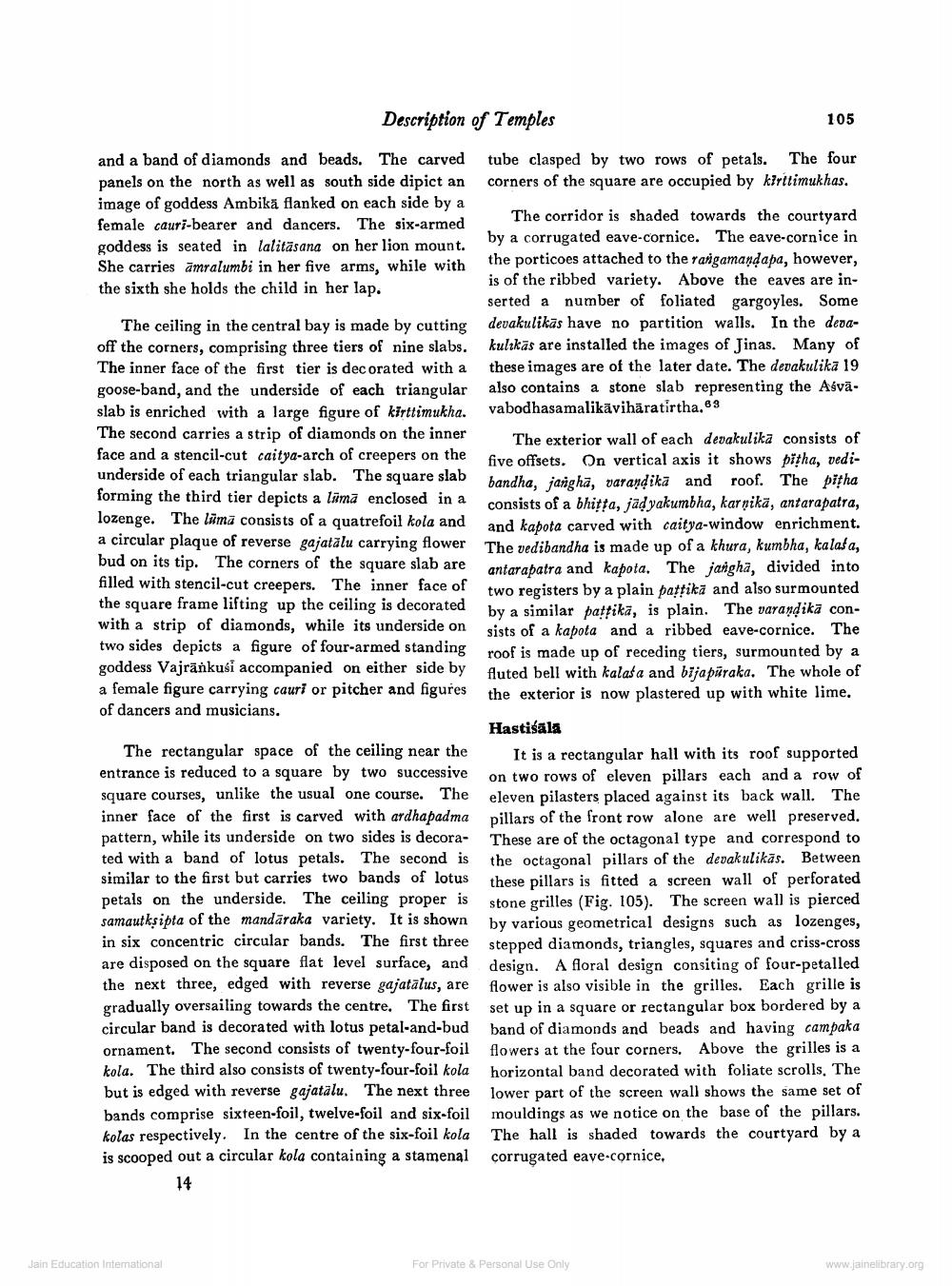________________
Description of Temples
105
and a band of diamonds and beads. The carved tube clasped by two rows of petals. The four panels on the north as well as south side dipict an corners of the square are occupied by kiritimukhas. image of goddess Ambikä flanked on each side by a
The corridor is shaded towards the courtyard female cauri-bearer and dancers. The six-armed goddess is seated in talitäsana on her lion mount.
by a corrugated eave-cornice. The eave-cornice in
the porticoes attached to the rangamandapa, however, She carries amralumbi in her five arms, while with
is of the ribbed variety. Above the eaves are inthe sixth she holds the child in her lap.
serted a number of foliated gargoyles. Some The ceiling in the central bay is made by cutting devakulikās have no partition walls. In the dedaoff the corners, comprising three tiers of nine slabs. kulikās are installed the images of Jinas. Many of The inner face of the first tier is decorated with a these images are of the later date. The devakulika 19 goose-band, and the underside of each triangular also contains a stone slab representing the Asvā. slab is enriched with a large figure of kirttimukha. vabodhasamalikāvihäratirtha. The second carries a strip of diamonds on the inner
The exterior wall of each devakulika consists of face and a stencil-cut caitya-arch of creepers on the five offsets. On vertical axis it shows pitha, vediunderside of each triangular slab. The square slab handha. jarigha, varandika and roof. The pisha forming the third tier depicts a limā enclosed in a consists of a bhitta, jad yakumbha, karnika, antarapatra, lozenge. The lūma consists of a quatrefoil kola and and kapota carved with caitya-window enrichment. a circular plaque of reverse gajatalu carrying flower The vedibandha is made up of a khura, kumbha, kalasa, bud on its tip. The corners of the square slab are antarapatra and kapota. The jangha, divided into filled with stencil-cut creepers. The inner face of two registers by a plain patrika and also surmounted the square frame lifting up the ceiling is decorated by a similar battika, is plain. The varandika conwith a strip of diamonds, while its underside on sists of a kabota and a ribbed eave-cornice. The two sides depicts a figure of four-armed standing
roof is made up of receding tiers, surmounted by a goddess Vajränkusi accompanied on either side by Auted bell with kalaša and bija püraka. The whole of a female figure carrying cauri or pitcher and figures the exterior is now plastered up with white lime, of dancers and musicians.
Hastiśāla The rectangular space of the ceiling near the It is a rectangular hall with its roof supported entrance is reduced to a square by two successive on two rows of eleven pillars each and a row of square courses, unlike the usual one course. The eleven pilasters placed against its back wall. The inner face of the first is carved with ardhapadma pillars of the front row alone are well preserved. pattern, while its underside on two sides is decora- These are of the octagonal type and correspond to ted with a band of lotus petals. The second is the octagonal pillars of the devakulikās. Between similar to the first but carries two bands of lotus these pillars is fitted a screen wall of perforated petals on the underside. The ceiling proper is stone grilles (Fig. 105). The screen wall is pierced samautksipta of the mandaraka variety. It is shown by various geometrical designs such as lozenges, in six concentric circular bands. The first three stepped diamonds, triangles, squares and criss-cross are disposed on the square flat level surface, and design. A floral design consiting of four-petalled the next three, edged with reverse gajatālus, are flower is also visible in the grilles. Each grille is gradually oversailing towards the centre. The first set up in a square or rectangular box bordered by a circular band is decorated with lotus petal-and-bud band of diamonds and beads and having campaka ornament. The second consists of twenty-four-foil flowers at the four corners. Above the grilles is a kola. The third also consists of twenty-four-foil kola horizontal band decorated with foliate scrolls. The but is edged with reverse gajatalu. The next three lower part of the screen wall shows the same set of bands comprise sixteen-foil, twelve-foil and six-foil mouldings as we notice on the base of the pillars. kolas respectively. In the centre of the six-foil kola The hall is shaded towards the courtyard by a is scooped out a circular kola containing a stamenal corrugated eave-cornice,
Jain Education International
For Private & Personal Use Only
www.jainelibrary.org




